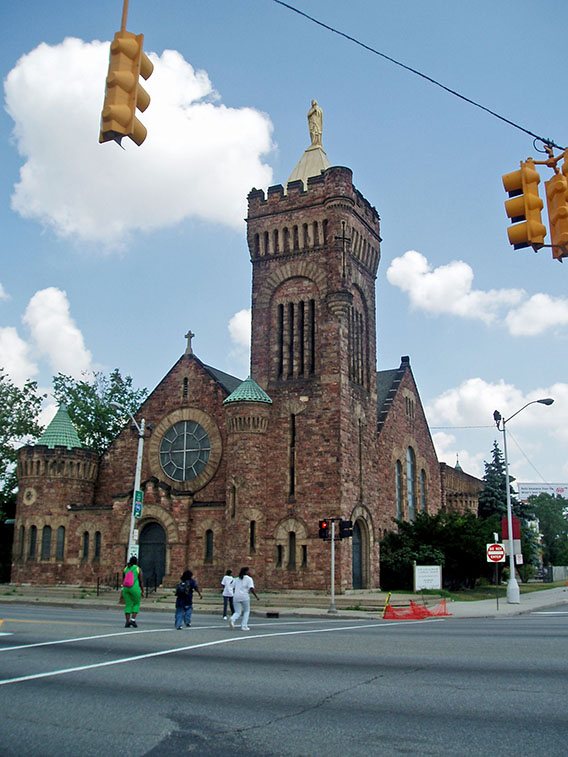

This is one of the most frequently seen churches in Detroit. But if you only glance at it as you race along on the Edsel Ford, you will never appreciate its architectural significance. Even from the expressway you will appreciate, at least on sunny days, the huge golden statue of the Blessed Virgin Mary that was added when ownership changed from Episcopalians to Roman Catholics.
I do not know how the Medbury family acquired wealth in Nineteenth Century Detroit, but I infer that they lived near the intersection of Medbury and Woodward. In the early 1880s, Mrs. L. R. Medbury funded the building of a small structure for St. Joseph’s Memorial Chapel. This quickly became a growing Episcopalian congregation. As membership increased, a larger church was needed, so this prosperous parish, from 1893 to 1896, constructed the Richardson Romanesque sandstone building that you see. There are many interesting embellishments to this church, perhaps too many. You see a small conical tower with numerous pillars to the north of the Woodward entrance. Then there is the impressive entrance itself with a large round window in the gable above the doorway. To the south there is another conical tower, smaller in dimension but taller than the tower to the north. Then there is the most impressive adornment. This is the corner tower at the intersection of Woodward and what was once Medbury but is now the Edsel Ford Freeway Service Drive. This soaring tower is topped by a corbelled and battlemented parapet. To minimize the rectangular native of this massive and dominating corner tower, the architects added a two story stair turret at the highest level.
By 1907, the Episcopalians were planning what is now St. Paul’s Cathedral at Warren and Woodward. I believe this is why they sold the church to the Roman Catholics for the sum of $19,500. After it came under new management, structural changes were made. The original design was that of a Greek cross, but the Catholics extended the sanctuary to make the building more nearly resemble the traditional Latin cross used in the design of many Roman Catholic churches. A chapel accompanied by a similarly sized and ponderous tower was designed in the Richardson Romanesque style and built behind the major church along what was Medbury. Finally, presumably without knowing that a busy expressway would someday run alongside their church, the Catholics added the gilt statue of the Blessed Virgin Mary. If you are interested in determining for yourself which is the most appealing of the city’s several Richardson Romanesque churches, you might compare Holy Rosary to its contemporaries: Cass Avenue United Methodist—also designed by Malcomson and Higginbotham; First Congregational and Trumbull Avenue Presbyterian.
Architects: William Malcomson and William Higginbotham
Architectural style: Richardson Romanesque
Construction material: Sandstone
Date of Construction: 1896
Date of conversion from Episcopalian to Roman Catholic: 1907
City of Detroit Local Historic District: Not listed
State of Michigan Registry of Historic Sites: P25230
National Register of Historic Places: #82002908 Listed August 3, 1982
Use in 2005: Church
Photograph: Ren Farley; 2005